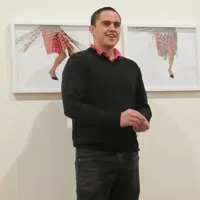Visual Arts - 10 Years: Reuben Friend
Written by

As part of The Big Idea’s celebration of ten years online, critic Mark Amery has brought together a discussion of those years in the visual arts from five leading visual arts practitioners - in response to his own thoughts.
On Friday we heard from artist Judy Millar. Today we welcome to the table Reuben Friend, curator of Maori and Pacific Art at City Gallery Wellington.
What are some of the things that have characterised the visual arts in the last ten years in relation to your particular interests and experience?
One of the areas of development that has really excited me over the last decade is the emergence of a new generation of young and confident artists of Pacific Island descent. While the 90s saw the emergence of a new school of hip young Maori artists, who are still going from strength to strength today, Pacific arts seemed to plateau for some time, as if the quota had been filled and there was no more space (or interest) for Pacific stories.
Now new generations of PI artists are coming out of the major art schools of New Zealand and building on the foundation laid down by the predecessors. Freed from the frangipani and tapa cloth aesthetic, which seemed to define and confine Pacific arts for so long, this new generation are able to engage in new mediums, materials and discourses in art without the baggage and expectations to conform to a stereotype.
What are some works of art and/or experiences you've had that speak strongly to the tenor of the last ten years?
One of the areas where these young Maori and Pacific artists seem to be particularly strong in is new media. Over the last decade I’ve really enjoyed watching artists such as Rachael Rakena, Janet Lilo, Ngahina Hohaia, Tanu Gago, Rangituhia Hollis and Leilani Kake (to list a few of my personal faves) pursuing this area of investigation from a Pacific perspective - providing kaupapa Pacific frameworks which coming generations will be able to engage with, build upon and grow from.
My favourite artwork of this nature, at the moment, is probably John Ioane’s Poly wants a Cracker from 2002, which used a mechanised mannequin playing a ukulele and swaying his hips to John’s favourite party songs. The work looks at the dynamics of sexual attraction and identity in the Pacific and was purchased by the Museum of New Zealand Te Papa Tongarewa but has rarely been shown in public institutions in New Zealand.
What are some changes in the visual arts sector in the past 10 years that have made it easier and/or harder for New Zealand artists to build a career?
Looking back at the last decade it would be hard to deny the impact of the Tautai Contemporary Pacific Arts Trust in terms of its support and promotion of young Pacific artists. Established by senior Pacific artists such as Fatu Feu’u and others, the Trust has become somewhat of a community, pulling young PI artists together from various institutions around the country to network and wananga ideas.
These types of communal art bodies for young artists of Maori descent have been long established and supported by some of the major tertiary institutions around NZ for many years now - including Toi Maori, Toihoukura, Te Putahi a Toi at Massey University and others - but it has not been until recent years that Pacific artists have started to experience a similar ground swell and sustained support from tertiary and public institutions.
Before the Tautai Trust, contemporary Pacific arts in Aotearoa New Zealand seemed relatively confined to a small and select group of artists, but now an entire generation of young Pacific artists seem to be enjoying the fruits of the labour of their predecessors.
What are some of the opportunities and challenges for the next decade?
Given the current climate (both social and environmental) I’m interested in how art can better the world - more than I am concerned about what’s the ‘next big thing’. Issues around climate change, human rights, corrupt banking systems, peak fuel and the exploitation of natural resources are all at the forefront of our minds - if not at least subdued somewhere in our subconscious beneath all the consumer advertising propaganda we seem to be inundated with these days.
I’d like to see activism in art come back in a strong way, where artists makes firm statements and draw attention to real issues as opposed to being concerned about making art about art - at least for the moment that is, while we as a species sort ourselves and our interaction with the environment out. But that’s my own personal bent more than a commentary on what I may envision for the future.
What does The Big Idea mean to you?
Like the Tautai Trust, The Big Idea is a communal focal point: a place where people come to share, engage and wananga ideas.
Further Information:
Reuben Friend (b.1981) is of Pakeha and Ngati Maniapoto heritage. Raised in Auckland and studying Te Reo Maori at the Auckland College of Education in 2001, he pursued a degree in Maori Visual Art at Toimairangi in Hawkes Bay, graduating in 2005, and completed a Masters in Maori Visual Art from Te Putahi a Toi Massey University, Palmerston North in 2010. Receiving the Doreen Blumdhart/ Creative New Zealand internship at The Dowse Art Museum in 2009, where he curated the Plastic Maori exhibition, he now currently works as the Curator of Maori and Pacific Art at City Gallery Wellington.